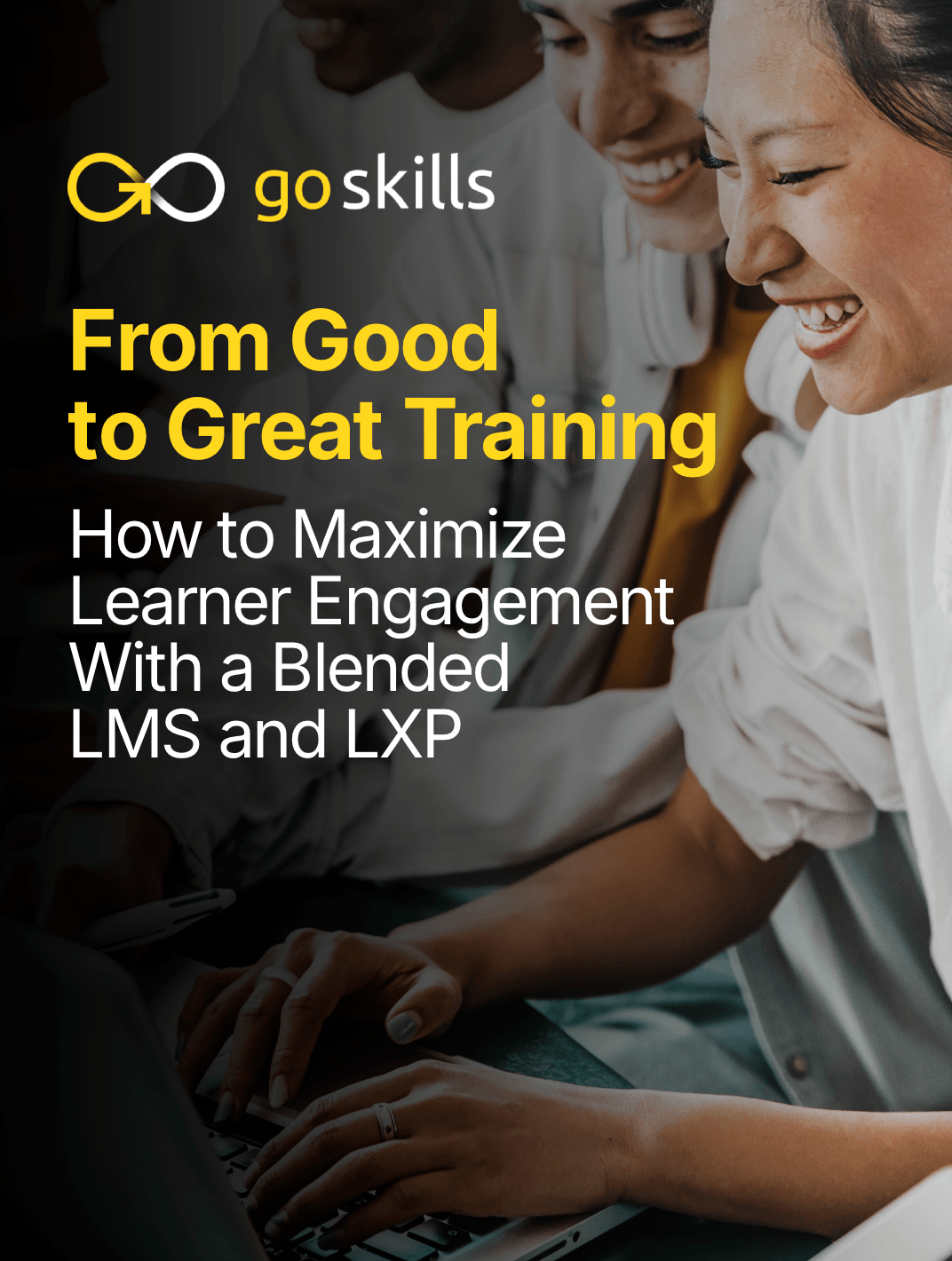
Using A Blended LMS And LXP To Boost Engagement
In our previous articles, we took a closer look at LMS and LXP models and explored how to make a strong business case for blended platforms. But once you get internal buy-in, how can you take engagement and personalization to the next level with a blended LMS and LXP solution, and what are the best practices for measuring impact?

eBook Release
From Good To Great Training: How To Maximize Learner Engagement With A Blended LMS And LXP
Discover how GoSkills combines the power of an LMS with an LXP to tackle engagement challenges head-on.
How To Leverage A Platform That Delivers The Benefits Of An LMS And LXP
1. Conduct A Skills Gap Assessment Before Training
A skills gap assessment provides a solid foundation for any personalized learning program. It ensures that the training you develop is precisely targeted to fill those gaps and enhance your team’s capabilities. Begin by accurately identifying your workforce’s current skills and pinpointing the areas that need development.
GoSkills offers learners a placement test before they start a course, providing a personalized skills analysis that highlights their strengths and areas for growth. This targeted insight motivates learners to address any skill gaps. By comparing their placement and final test results, learners can see their progress, while administrators gain valuable insights into the course’s impact.
2. Create Targeted Assignments And Learning Paths
Once you have a clear skills analysis, you can use the GoSkills Assignments and Learning Paths features to seamlessly address the areas that need attention. Creating specific, focused tasks not only makes the learning experience more relevant, but also ensures that every minute spent training is effective and directly beneficial to improving job performance.
You can also set due dates for courses, helping to create a more structured and organized learning experience. The Teams feature allows administrators to create specific groups within the organization, making it easy to deliver tailored learning experiences to different teams and departments.
3. Monitor Progress And Adapt Learning Paths
Personalized learning is a dynamic journey. By monitoring each learner’s progress regularly, you can use data to adapt their learning paths in real time. This approach ensures that training stays aligned with the pace of individual learners and their evolving needs, maximizing engagement and learning outcomes.
GoSkills offers robust reporting capabilities to offer insights at every level–from individual lesson impact to entire course effectiveness, and from single learner progress to team-wide performance.
With the GoSkills course builder, you can also add course review forms to capture qualitative feedback, helping you make ongoing improvements to the course.
4. Embrace Adaptive Learning Technologies
Leverage cutting-edge adaptive learning technologies that utilize AI and machine learning. We’ve introduced our course recommender: an AI-powered tool that offers personalized course suggestions tailored to learners’ specified goals and activities. Learners can also receive tailored recommendations for learning materials directly on their dashboard.
5. Promote Learner Autonomy
Empower learners by involving them in their own learning process. Allowing choices in the timing, pace, and even the type of content accessed, promotes a sense of ownership and motivation toward learning. This autonomy not only enhances engagement, but also encourages learners to take responsibility for their development, leading to higher satisfaction and better course completion rates.
Measuring Engagement With The GoSkills LMS/LXP
Robust analytics are essential for evaluating the effectiveness of your learning programs. Here’s how you can track and assess employee engagement:
1. Course Completion Rates
Track the percentage of employees who complete assigned courses. Higher completion rates indicate strong engagement, while incomplete courses might highlight areas for improvement.
2. Time Spent Learning
Use GoSkills analytics to monitor how much time employees are dedicating to their learning journey. Increased time spent on courses often correlates with higher engagement.
3. Quizzes And Test Scores
Evaluate employees’ performance on quizzes and assessments within the platform. High scores show comprehension and application of knowledge, while lower scores might indicate a need for further support or content adjustment.
4. Learner Feedback
All of our courses include a built-in feedback form to gather direct input from employees about their learning experience. Understanding what they find valuable or challenging can provide insights into how engaged they are with the content.
5. Voluntary Learning Participation
GoSkills’ LXP functionality allows employees to explore courses beyond those assigned. Tracking voluntary course participation and engagement can reveal their enthusiasm for self-driven learning.
6. Progression In Learning Paths
Measure how employees progress through defined learning paths. This provides an indication of their commitment to development and mastery of new skills.
Promotion And Career Growth
Monitor whether employees who engage with GoSkills are progressing within the organization. Increased promotion rates or career advancements can be a strong indicator of learning engagement translating to real-world success.
By leveraging GoSkills’ built-in reporting features, you can gain valuable insights into employee engagement, identify areas for improvement, and ensure that your training strategy fosters a culture of continuous learning and development.
Want to know more about how a blended LMS and LXP solution can create a more powerful learning strategy? Download From Good To Great Training: How To Maximize Learner Engagement With A Blended LMS And LXP today to discover how you can leverage a blended platform to make your training initiatives more practical, effective, and learner-centered.